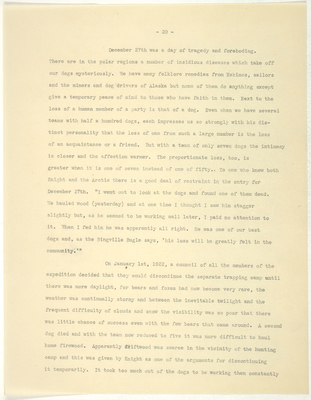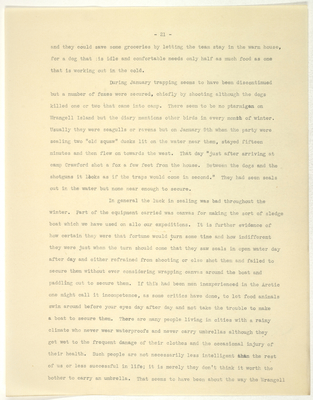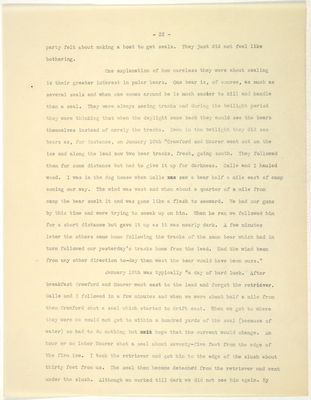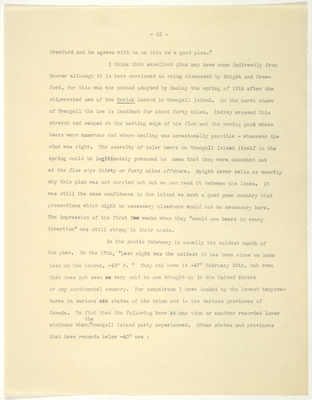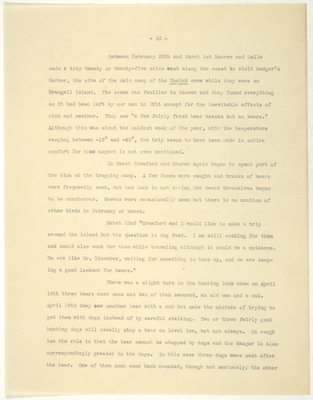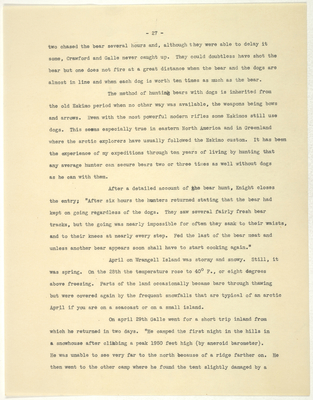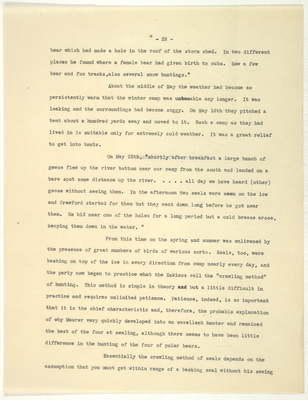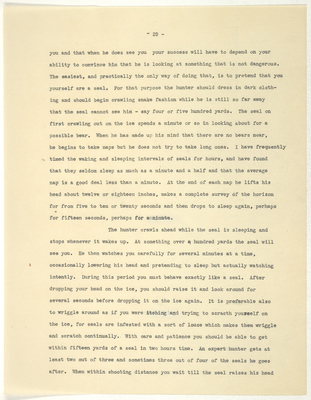Pages That Need Review
stefansson-wrangel-09-25-006
stefansson-wrangel-09-25-006-020
- 20 -
December 27th was a day of tragedy and foreboding. There are in the polar regions a number of insidious diseases which take off our dogs mysteriously. We have many folklore remedies from Eskimos, sailors and the miners and dog drivers of Alaska but none of them do anything except give a temporary peace of mind to those who have faith in them. Next to the loss of a human member of a party is that of a dog. Even when we have several teams with half a hundred dogs, each impresses us so strongly with his distinct personality that the loss of one from such a large number is the loss of an acquaintance or a friend. But with a team of only seven dogs the intimacy is closer and the affection warmer. The proportionate loss, too, is greater when it is one of seven instead of one of fifty. To one who knew both Knight and the Arctic there is a good deal of restraint in the entry for December 27th. "I went out to look at the dogs and found one of them dead. We hauled wood (yesterday) and at one time I thought I saw him stagger slightly but, as he seemed to be working well later, I paid no attention to it. When I fed him he was apparently all right. He was one of our best dogs and, as the Bingville Bugle says, 'his loss will be greatly felt in the community.'"
On , a council of all the members of the expedition decided that they would discontinue the separate trapping camp until there was more daylight, for bears and foxes had now become very rare, the weather was continually stormy and between the inevitable twilight and the frequent difficulty of clouds and snow the visibility was so poor that there was little chance of success even with the few bears that came around. A second dog died and with the team now reduced to five it was more difficult to haul home firewood. Apparently driftwood was scarce in the vicinity of the hunting camp and this was given by Knight as one of the arguments for discontinuing it temporarily. It took too much out of the dogs to be working them constantly
stefansson-wrangel-09-25-006-021
- 21 -
and they could save some groceries by letting the team stay in the warm house, for a dog that is idle and comfortable needs only half as much food as one that is working out in the cold.
During January trapping seems to have been discontinued but a number of foxes were secured, chiefly by shooting although the dogs killed one or two that came into camp. There seem to be no ptarmigan on Wrangell Island but the diary mentions other birds in every month of winter. Usually they were seagulls or ravens but on when the party were sealing two "old squaw" ducks lit on the water near them, stayed fifteen minutes and then flew on towards the west. That day "just after arriving at camp Crawford shot a fox a few feet from the house. Between the dogs and the shotguns it looks as if the traps would come in second." They had seen seals out in the water but none near enough to secure.
In general the luck in sealing was bad throughout the winter. Part of the equipment carried was canvas for making the sort of sledge boat which we have used on allo our expeditions. It is further evidence of how certain they were that fortune would turn some time and how indifferent they were just when the turn should come that they saw seals in open water day after day and either refrained from shooting or else shot them and failed to secure them without ever considering wrapping canvas around the boat and paddling out to secure them. If this had been men inexperienced in the Arctic one might call it incompetence, as some critics have done, to let food animals swim around before your eyes day after day and not take the trouble to make a boat to secure them. There are many people living in cities with a rainy climate who never wear waterproofs and never carry umbrellas although they get wet to the frequent damage of their clothes and the occasional injury of their health. Such people are not necessarily less intelligent than the rest of us or less successful in life; it is merely they don't think it worth the bother to carry an umbrella. That seems to have been about the way the Wrangell
stefansson-wrangel-09-25-006-022
- 22 -
party felt about making a boat to get seals. They just did not feel like bothering.
One explanation of how careless they were about sealing is their greater interest in polar bears. One bear is, of course, as much as several seals and when one comes around he is much easier to kill and handle than a seal. They were always seeing tracks and during the twilight period they were thinking that when the daylight came back they would see the bears themselves instead of merely the tracks. Even in the twilight they did see bears as, for instance, on "Crawford and Maurer went out on the ice and along the lead saw two bear tracks, fresh, going south. They followed them for some distance but had to give it up for darkness. Galle and I hauled wood. I was in the dog house when Galle xxx saw a bear half a mile east of camp coming our way. The wind was west and when about a quarter of a mile from camp the bear smelt it and was gone like a flash to seaward. We had our guns by this time and were trying to sneak up on him. When he ran we followed him for a short distance but gave it up as it was nearly dark. A few minutes later the others came home following the tracks of the same bear which had in turn followed our yesterday's tracks home from the lead. Had the wind been from any other direction to-day than west the bear would have been ours."
was typically "a day of hard luck. After breakfast Crawford and Maurer went east to the lead and forgot the retriever. Galle and I followed in a few minutes and when we were about half a mile from them Crawford shot a seal which started to drift east. When we got to where they were we could not get to within a hundred yards of the seal (because of water) so had to do nothing but wait hope that the current would change. An hour or so later Maurer shot a seal about seventy-five feet from the edge of the firm ice. I took the retriever and got him to the edge of the slush about thirty feet from us. The seal then became detached from the retriever and went under the slush. Although we worked till dark we did not see him again. By
stefansson-wrangel-09-25-006-023
- 23 -
this time the other seal had disappeared completely."
The retriever mentioned by Knight is an Eskimo device for getting seals that have been shot not too far away in open water. It consists of an knob of wood about the size of a grapefruit with several sharp recurved steel hooks around its circumference and a loop at one end to which is attached a slender line one hundred or more feet in length. The line is held coiled in the left hand. With the right hand you grasp the line about five feet from the end and swing it around your head until it makes a whistling noise. You then throw it, paying out the line as the retriever flies through the air. You should throw it farther then where the dead seal lies floating horizontally on the water. You then pull slowly towards you until the knob is about to slide over the seal when you give a sharp jerk and one of the hooks catches in his hide. You then pull in hand over hand. This brings the seal to you usually if there is no slush ice, but the trouble is that on any but an exceptionally warm day slush forms along the edge of the firm ice where you are standing and you are not able to haul the seal right up to you. In such circumstances we usually make a boat out of a sledge, as we have mantioned, wrapping a canvas around it. But, as we have said above, the Wrangell party did not seem to have thought this worth the bother, expecting continually to be successful later by the, in a way, simpler methods which they were using.
Still, the experience of the day we have just described seems to have impressed Knight with the advisability of using a boat later, for on January 19th he tells about making preparation to that end.
For several days after the 19th the sealing was interfered with by too much open water. The most favorable condition is when the wind merely cracks the ice and drives it off a few yards or at the most a few hundred yards, making what is called an open lead. But now the wind was so strong
stefansson-wrangel-09-25-006-025
- 25 -
Crawforf and he agrees with me on this as a good plan."
I think this excellent plan may have come indirectly from Maurer although it is here mentioned as being discussed by Knight and Crawford, for this was the method adopted by Hadley the spring of 1914 after the shipwrecked men of the Karluk landed in Wrangell Island. On the north shore of Wrangell the ice is landfast for about forty miles. Hadley crossed this stretch and camped at the meeting edge of the floe and the moving pack where bears were numerous and where sealing was occasionally possible - whenever the wind was right. The scarcity of polar bears on Wrangell Island itself in the spring could be legitimately presumed to mean that they were abundant out at the floe edge thirty or forty miles offhsore. Knight never tells us exactly why this plan was not carried out but we can read in between the lines. It was still the same confidence in the island as such a good game country that precautions which might be necessary elsewhere would not be necessary here. The impression of the first few weeks when they "could see bears in every direction" was still strong in their minds.
In the Arctic February is usually the coldest month of the year. On the 17th, "Last night was the coldest it has been since we have been on the island, -40oF." They did have it -47o February 25th, but even that does not seem xx very cold to one brought up in the United States or any continental country. For comparison I have looked up the lowest temperatures in various xxx states of the Union and in the various provinces of Canada. We find that the following have at one time or another recorded lower minimums than the Wrangell Island party experienced. Other states and provinces that have records below -40o are:
stefansson-wrangel-09-25-006-026
- 26 -
Between February 26th and March 1st Maurer and Galle made a trip twenty or twenty-five miles east along the coast to visit Rodger's Harbor, the site of the main camp of the Karluk crew while they were on Wrangell Island. The scene was familiar to Maurer and they found everything as it had been left by our men in 1914 except for the inevitable effects of wind and weather. They saw "a few fairly fresh bear tracks but no bears." Although this was about the coldest week of the year, with the temperature ranging between -16o and -42o, the trip seems to have been made in entire comfort for that aspect is not even mentioned.
In March Crawford and Maurer again began to spend part of the time at the trapping camp. A few foxes were caught and tracks of bears were frequently seen, but bad luck in not seeing the bears themselves began to be monotonous. Ravens were occasionally seen but there is no mention of other birds in February or March.
March 22nd "Crawford and I would like to make a trip around the island but the question is dog feed. I am still cooking for them and could also cook for them while traveling although it would be a nuicance. We are like Mr. Micawber, waiting for something to turn up, and we are keeping a good lookout for bears."
There was a slight turn in the hunting luck when on April 16th three bears were seen and two of them secured, an old one and a cub. April 26th they saw another bear with a cub but made the misatke of trying to get them with dogs instead of by careful stalking. Two or three fairly good hunting dogs will usually stop a bear on level ice but not always. In rough ice the rule is that the bear cannot be stopped by dogs and the danger is also correspondingly greater to the dogs. In this case three dogs were sent after the bear. One of them soon came back wounded, though not seriously; the other
stefansson-wrangel-09-25-006-027
- 27 -
two chased the bear several hours and, although they were able to delay it some, Crawford and Galle never caught up. They could doubtless have shot the bear but one does not fire at a great distance when the bear and the dogs are almost in line and when each dog is worth ten times as much as the bear.
The method of hunting bears with dogs is inherited from the old Eskimo periods when no other way was available, the weapons being bows and arrows. Even with the most powerful modern rifles some Eskimos still use dogs. This seems especially true in eastern North America and in Greenland where the arctic explorers have usually followed the Eskimo custom. It has been the experience of expeditions through ten years of living by hunting that any average hunter can secure bears two or three times as well without dogs as he can with them. After a detailed account of the bear hunt, Knight closes the entry; "After six hours the hunters returned stating that the bear had kept on going regardless of the dogs. They saw several fairly fresh bear tracks, but the going was nearly impossible for often they sank to their waists, and to their knees at nearly every step. Fed the last of the bear meat and unless another bear appears soon shall have to start cooking again."
April on Wrangell Island was stormy and snowy. Still, it was spring. On the 28th the temperature rose to 40oF., or eight degrees above freezing. Parts of the land occasionally became bare through thawing but were covered again by the frequent snowfalls that are typically of an arctic April if you are on a seacoast or on a small island.
On april 29th Galle went for a short trip inland from which he returned in two days. "He camped the first night in the hills in a snowhouse after climbing a peak 1950 feet high (by aneroid barometer). He was unable to see very far to the north because of a ridge farther on. He then went to the other camp where he found the tent slightly damaged by a
stefansson-wrangel-09-25-006-028
- 28 -
bear which had made a hole in the roof of the storm shed. In two different places he found where a female bear had given birth to cubs. Saw a few bear and fox tracks, also several snow buntings."
About the middle of May the weather had become so perisistently warm that the winter camp was [anbenable] any longer. It was leaking and the surroundings had become soggy. On May 18th they pitched a tent about a hundred yards away and moved to it. Such a camp as they had lived in is suitable only for extremely cold weather. It was a great relief to get into tents.
On May 25th, "shortly after breakfast a large bunch of geese flew up the river bottom near out camp from the south and landed on a bear spot some distance up the river. .... all day we have heard (other) geese without seeing them. In the afternoon two seals were seen on the ice and Crawford started for them but they went down long before he got near them. He hid near one of the holes for a long period but a cold breeze arose, keeping them down in the water."
From this time on the spring and summer was enlivened by the presence of great numbers of birds of various sorts. Seals, too, were basking on top of the ice in every direction from camp nearly every day, and the party now began to practice what the Eskimos call the "crawling method" of hunting. This method is simple in theory xxx but a little difficult in practice and required unlimited patience. Patience, indeed, is so important that it is the chief characteristic and, therefore, the probable explanation of why Maurer very quickly developed into an excellent hunter and remained the best of the four at sealing, although there seems to have been little difference in the hunting of the four polar bears.
Essentially the crawling method of seals depends on the assumption that you must get within range of a basking seal without his seeing.
stefansson-wrangel-09-25-006-029
- 29 -
you and that when he does see you your success will have to depend on your ability to convince him that he is looking at something that is not dangerous. The easiest, and practically the only way of doing that, is to pretend that you yourself are a seal. For that purpose the hunter should dress in dark clotheing and should begin crawling snake fashion while he is still so far away that the seal cannot see him - say four or five hundred yards. The seal on first crawling out ont he ice spends a minute or so in looking about for a possible bear. When he had made up his mind that there are no bears near, he begins to take naps but he does not try to take long ones. I have frequently timed the waking and sleeping intervals of seals for hours, and have found that they seldom sleep as much as a minute and a half and that the average nap is a good deal less than a minute. At the end of each nap he lifts his head about twelve or eighteen inches, makes a complete survey of the horizon for from five to ten or twenty seconds and then drops to sleep again, perhaps for fifteen seconds, perhaps for a minute.
The hunter crawls ahead while the seal is sleeping and stops whenever it wakes up. At something over a hundred yards the seal will see you. He then watches you carefully for several minutes at a time, occasionally lowering his head and pretending to sleep but actually watching intently. During this period you must behave exactly like a seal. After dropping your head on the ice, you should raise it and look around for several seconds before dropping it on the ice again. It is preferable also to wriggle around as if you were itching and trying to scratch yourself on the ice, for seals are infested with a sort of louse which makes them wriggle and scratch continually. With care and patience you should be able to get within fifteen yards of a seal in two hours time. An expert hunter gets at least two out of three and sometimes three out of four of the seals he goes after. When within shooting distance you wait till the seal raises his head
stefansson-wrangel-09-25-006-035
- 35 -
sleet not infrequently and snow occasionally. There is no complete weather record but on August 11th Knight mentions, for instance, "when I arose the ground was covered with about two inches of snow which soon melted." He evidently found it a very strange summer, having experienced among the Canadian islands so much more sunshine and warmth at the corresponding season five hundred miles farther north.
Although the party were now taking advantage of every hunting opportunity, the entry for August 17th shows that they were by no means worried over the situation. With plenty of driftwood available for fuel and with Knight praising its quality constantly, we are now told that "the last couple of days Galle has been trying out bear blubber for cooking purposes.” That would correspond to cooking with butter or bacon fat, something no one would do who was in fear of hunger.
The hunting at this stage was generally successful although the amount of game was not large. But there are always spells of bad luck in hunting, as on August 20th when "a large bear was spotted about a mile to the west on the beach coming this way. Crawford, Maurer and Galle set out intending to hide near the other side of the river and wait for him to come up. But the bear started up the xxxxx west side of the river and Crawford and Galle took after him. The bear saw them and the last we saw of him was a white streak going north."
It was now that the lack of the Eskimo skin boat began to be felt. August 29th was "a beautiful day but cold. .... A great many walrus heard offshore but too far away to be seen and too far to go after because of the ice." This ice which was insuperable to men with a dory would have been almost an advantage to the same party equipped with a skin boat. During the next two or three days the walrus were continually heard snorting, but were usually either beyond the horizon or hidden by the ice.
